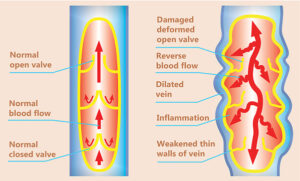A venous disease occurs when a patient’s veins are obstructed, causing stagnation — or even the backward flow — of blood in the body. Due to pressure build-up in the afflicted veins, various physical and cosmetic symptoms may arise as a result.
Two common venous diseases include spider veins and varicose veins. Spider veins appear as discoloration in the skin in response to the stagnation of blood on the skin’s surface. In contrast, varicose veins are twisted, swollen veins just below the skin’s surface with the potential to cause pain and discomfort.
The diagnosis process for a venous disease involves using ultrasound technology to effectively and efficiently locate stagnation in various extremities. From there, our team will be able to provide you with the best treatment option to suit your needs. From surface-level discoloration and blemishes to constant pain or discomfort, our team will resolve your venous disease symptoms at the source, thereby restoring your comfort, enhancing your wellness, and rejuvenating your confidence.

Treatment Options For Venous Diseases
VenaSeal™
The VenaSeal procedure delivers a small amount of a specially formulated medical adhesive to seal — or close — the diseased vein, rerouting blood to nearby healthy veins and providing symptom relief. The VenaSeal closure system is a safe and effective treatment, offering significant improvement in quality of life.
Radiofrequency Ablation
Radiofrequency Ablation, or RF Ablation, is a minimally-invasive option for treating diseased veins wherein short bursts of radiofrequency energy are used to break down collagen in the veins, effectively causing the vessels to collapse. As a result, the blood flow will be redirected to other, healthier veins.
This method of treatment is often used in addition to sclerotherapy and ultrasound guidance.
Deep Venous Disease
When further complications within the deep vein system occur, the other treatment options may not successfully relieve symptoms as expected. Under these circumstances, our physician will monitor blood circulation by injecting a dye into the femoral veins and tracking its progress using ultrasound technology.
Depending on the results, a patient may require a balloon angioplasty or atherectomy to provide a successful, long-lasting outcome.